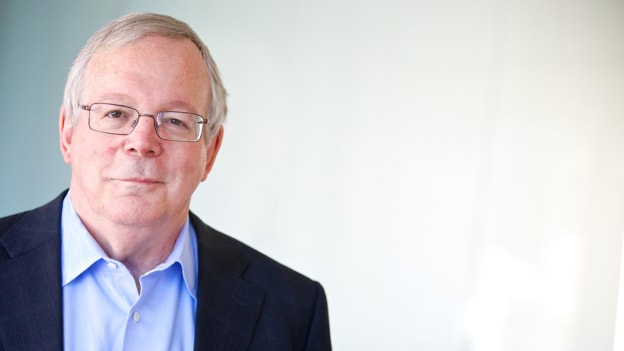Can’t solve 21st century problems with 20th century ways of thinking: PwC Network’s Blair Sheppard

In the new millennium, we found ourselves trying to solve 21st century problems with 20th century ways of thinking. And the problems we were facing were so big were so severe that huge changes were needed
The COVID-19 pandemic has brought problems to the fore that we had not even imagined. A huge repair job is needed and it is indeed time to rethink - strategy, structure, culture, and leadership. It is an opportunity for us to reset our approach and pave the way for a better future.
Blair Sheppard is the Global Leader, Strategy, and Leadership for the PwC Network, a network of professional services firms committed to building trust in society and solving important problems. He proposes “The Six Paradoxes of Leadership” that work as a system, forcing leaders to balance competing characteristics, abilities, and beliefs. In this exclusive interaction, Sheppard talks about these six paradoxes of leadership, the four global crises we face today and how they are interconnected with each other and the coronavirus crisis, the need to reset our approach, and more.
Sheppard is also the author of TEN YEARS TO MIDNIGHT: Four Urgent Global Crises and Their Strategic Solutions (August 4, 2020; Berrett-Koehler Publishers) and Dean Emeritus and Professor Emeritus of Duke University’s Fuqua School of Business, where he taught for thirty-three years. He was the principal force behind opening Duke's campus in China and the founder and CEO of Duke Corporate Education.
Here are the excerpts from the interview:
Why is our current moment, like the Marshall Plan 70 years ago, a milestone to reset, rethink, and rebuild the direction of society for a better future?
After World War II, the economies of many countries were devastated, and a large number needed to be rebuilt from the ground up. The Marshall Plan provided the funding to do that and eventually evolved into economies and societies, at least outside the socialist regime countries, that we can think of as having distinctive characteristics in terms of four elements - strategy, structure, culture, and leadership. The strategy evolved into global interconnectivity with singular measures of success at the national (GDP) and corporate (shareholder value) levels. The structure was primarily through institutions built to sustain multilateralism, free markets, and technological interconnectivity. The culture was largely market-based and technology-focused, and leadership was provided by what we’d call economically sophisticated globalists. This system worked great for about 70 years until it didn’t.
In the new millennium, we found ourselves trying to solve 21st century problems with 20th century ways of thinking. And the problems we were facing were so big were so severe that huge changes were needed. In that sense, the tragedy and suffering of the COVID-19 pandemic have also presented us with an urgent opportunity to reset our approach. Of course, we have a huge repair job to do when it comes to the balance sheets of governments and businesses, just to stop the bleeding, but then we have the chance to rethink all of the elements I mentioned before - strategy, structure, culture, and leadership and then reconfigure them so that they are ready to take on the really big challenges that we face, like climate change and a world transformed by technology and income inequality. Strategy will have to focus more on local first and inclusive success, structurally, institutions will have to address those big challenges with new logic and more agility, culturally we will need to become more human-centered, more balanced, and more replenishing. And the leaders that will be needed will have to be able to hold and manage paradoxes that are inherent in the new world – like how to be a tech-savvy humanist or a globally-minded localist. We’d better get it right because the four crises won’t wait.
What are the four global crises we face today and how are they interconnected with each other and the coronavirus crisis?
A number of forces have been interacting over the last few decades to create what we have described in the book as the four global crises. The first one is the crisis of prosperity: basically, when the general population is not prospering, societies are in deep trouble. The crisis of prosperity plays out across what we’ve come to identify as the four fragile groups: those who are young and falling behind, those who are in danger of retiring broke, and in between, the encumbered - or squeezed - middle. The fourth group is composed of those who were barely scraping by and have now been effectively pushed off a cliff. Second is the crisis of technology; this is a host of issues ranging from the dominance of the tech giants and pervasiveness of tech platforms, unintended harms of technology like the negative psychological impacts of social media, and, critically, the way that AI and robotics are threatening jobs and livelihoods. Third is the crisis of institutional legitimacy; our institutions are no longer fit for purpose, because of disruption, fragmentation, and changing demographics, among other things. Fourth is the crisis of leadership; basically, we have become so divided that leaders can’t or won’t tackle the biggest problems that threaten every one of us.
Also Read...
- Companies continuing with HR tech investments aren’t just those that are financially stable: Colin Brennan
- The pandemic offers an opportunity to build fairer societies and economies by investing in people: IMF's Kalpana Kochhar
- Companies that succeed amid COVID-19 will be those that prioritize people: Walmart’s Donna Morris
- Companies are going through massive transformations and there is no going back: Josh Bersin
What trends caused these crises?
This question takes us back to what caused us to write Ten Years to Midnight in the first place. Before the pandemic, I used to travel a lot and I always took the opportunity to talk with people from all walks of life who I interacted with, whether those were CEOs or people in airports or taxi drivers, and ask them about their lives and their biggest concerns. I was really struck by how so many of these people had the same concerns, like "Will my kids do better than me or worse?" "Will the climate heat up so much that it will be too late to do anything about it?" "Do we have the leaders we need?" and "Are we hopelessly divided?"
As a result of these conversations, we developed a framework to which we gave the acronym ADAPT to describe five global trends that societies around the world are confronted within the new millennium. Those five challenges are: Asymmetry, by which we mean increasing wealth disparity and the erosion of the middle class; Disruption or the pervasive nature of technology and its impact on individuals, society, and our climate; Age, which stands for demographic pressure on business, social institutions, and economies; Polarization which includes the breakdown in global consensus and a fracturing world, with growing nationalism and populism; and Trust, which refers to declining confidence in the institutions that underpin society.
What new kind of a leader is needed to solve today's four crises?
Well, in order to apply 21st century thinking to 21st century problems, leaders need to understand the forces I’ve already described and how they interact, but they also need to be able to approach problems while holding seemingly opposite qualities in mind by embracing what I call the Six Paradoxes of Leadership. This is not an easy undertaking. Many leaders—indeed, all of us—gravitate toward our sweet spots; to what we do well. But by definition, paradoxes require that we use our best skills while also improving those traits we would prefer to avoid.
The Six Paradoxes of Leadership work as a system, forcing us to balance competing characteristics and beliefs. At the heart of each paradox is a core tension that involves contradictory-yet-interrelated elements that exist simultaneously and persists over time. When these characteristics are out of sync, the outcome is almost always disappointing. So, think of the high-profile executive hero who saves an organization from the brink of disaster but lacks the humility to seek advice or the ability to change course; more than likely, that campaign will end in failure. The six paradoxes I’ll list here aren’t the only ones leaders will encounter, but I think they are the ones most urgently needed to confront the problems I’ve already described. The six are: tech-savvy humanist; globally minded localist; strategic executor; humble hero; traditioned innovator; and high-integrity politician.
What needs to be done to restore trust in our institutions?
The challenge for institutions is for them to be able to change rapidly without inciting insecurity in the society they are designed to serve and without damaging the essential oversight that makes them stable forces in the world. To stay relevant, the institutions must change and fast, but, if they do it in the wrong way, they risk disenfranchising the people they are designed to serve. And if they change too slowly, they risk irrelevance. So, it’s very much a balancing act.
What needs to be done varies to a certain degree with the type of institution we’re talking about – so multilateral organizations versus educational institutions versus, say media. But, by and large, there are four elements that are essential to revitalizing our institutions. First, they need to identify their own core principles and then innovate around them. That essentially means they must think long and hard about what is absolutely vital and what can and must be changed. Second, they need to design the institution’s operations to survive and improve people’s lives in a fractured world. That’s not the world in which most of the institutions we rely on were born. Third, they have to accelerate new ideas and their execution while not alienating those who fear change. That’s a tricky thing because in times of great disruption many people seek to lessen their anxiety by shying away from change. Fourth, they must forge intimate connections with the local community and the people to be served. Much of the distrust comes from the sense that institutions are disconnected and uncaring.
How can any of us apply a Local First mindset as a first step toward solving our global crises?
Well, you could say that a Local First mindset is a step toward solving local problems and that the aggregation of these could indeed help us ultimately solve global crises. But that actually undervalues the possibilities of Local First, because one thing that they do is free up and multiply one of the greatest forces in the world: human ingenuity.
Local First is about self-sustaining, continuously improving local economic ecosystems and it’s the ideal way for any of us to start to make a difference. Whereas multinational corporations became unmoored and essentially nationless, causing their connection to the locations of which they’re a part to be severed, Local First systems are fundamentally about the common good, and they also allow people to feel and see how they make a difference. They turn on local entrepreneurs devising local solutions to local problems which leads to dynamic local economies. Of course, Local First will happen more quickly if these local entrepreneurs can count on resources in the form of organizational, operational, and design expertise as well as financial support from the private sector and philanthropists in developed economies. But, when a Local First mindset focuses it on the common good, amazing things can happen that might have impacts far beyond the local.
How will today's crises test our ability to scale solutions at speed as never before?
There are two crises in particular that stand out as undeniably massive, desperately pressing, and badly in need of creative solutions as well as focused and concerted attention from countries around the world, and those are job losses from automation and climate change. Conservative estimates suggest that as many as 10 percent of jobs in the world will be eliminated over the next ten years by automation, so that means we’d need to retrain and find positions for three hundred million people currently in the workforce. To add to this challenge, there are more than one billion youth under twenty years old living in underdeveloped countries who need education now and a job in the next ten years. Next, let’s consider the global crisis of climate change. Estimates of the effects of global warming suggest we have little more than a decade to dramatically modify our carbon footprint before things are potentially irreversible. Flooding, drought, and intense summer heat as well as violent storms could become the new normal. Drastic changes in global water supplies could severely compromise global health, availability of food, and fragile ecosystems. It’s hard to imagine two problems that are larger in scope and they’re both playing out over the next 10 years.
Simply put, we will not be able to address these crises fast enough if we depend on the speed of decision-making and implementation typical of the past seventy years. We need to do some important things on a very big scale, very quickly.
Read more such stories from the November 2020 issue of our e-magazine on 'The State of Digital HR’















